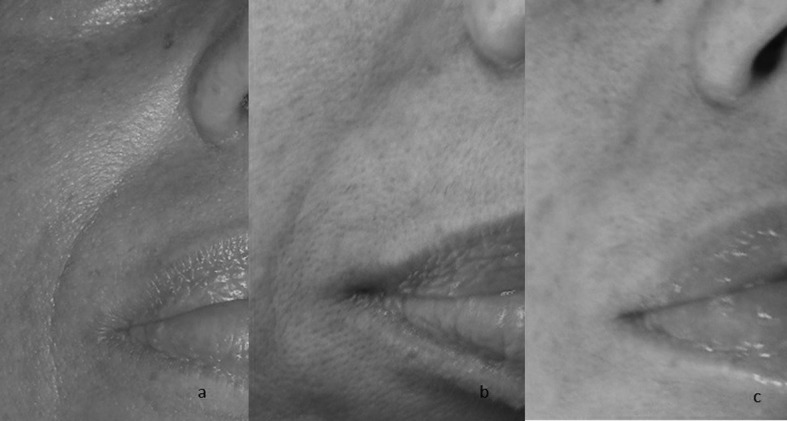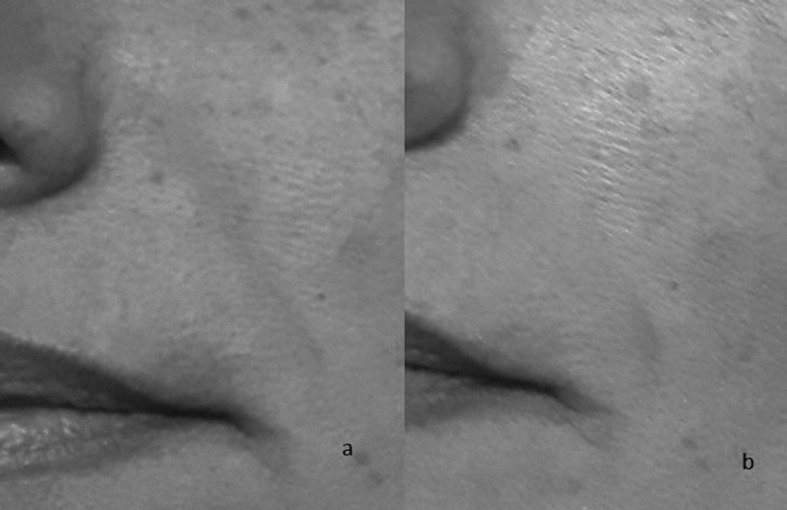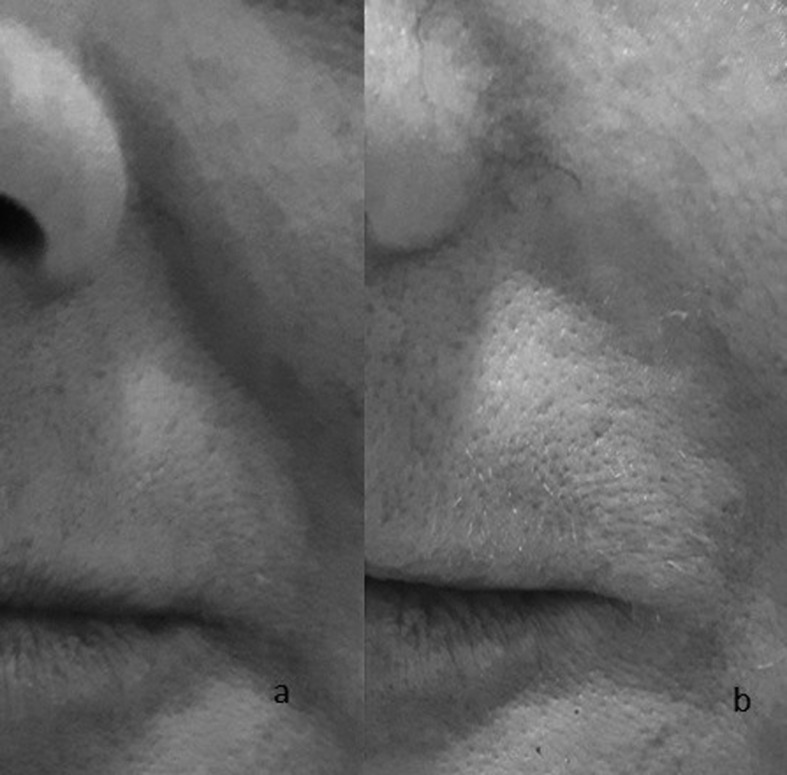Abstract
Introduction:The slowing of the aging process is subject of great research and attention in modern society, particularly aging of face. Processes involved are very complex. Mesotherapy. hyaluronic acid and carbon dioxide injection can be used for biorevitalization and skin rejuvenation. Methods:Three groups were made and 62 patients were enrolled. Patients with superficial wrinkles of the face, neck and/or décolleté, without presence of nasolabial folds and marionette wrinkles were included in group 1. Patients with superficial/medium depth wrinkles of the face, neck and/or décolleté, with moderate nasolabial folds but no marionette wrinkles were included in group 2. Patients with deep wrinkles of the face, with deep nasolabial folds and marionette wrinkles were included in group 3. Patients were treated with three different protocols that included injections of amino acids, vitamins and hyaluronic acid in association with carbon dioxide injection. We submitted the PAIS and GAIS scales and we analyzed the scores obtained with Wilcoxon’s and Kolmogorov-Smirnov’s tests. Statistical Product and Service Solutions (SPSS) softare was used. The p-value was considered acceptable if inferior to 0,05 (p>0,05). Results:In according with these tests, the differences of values at one week and at the end of the study are significant (p<0,05) for both PAIS and GAIS. No side effects were reported. Conclusions:Protocol treatment used in this study gave statistically valid results in the rejuvenation of face for mild, moderate and severe aging. (www.actabiomedica.it)
Keywords: face rejuvenation, carbon dioxide, carboxytherapy, biorevitalization
Introduction
The slowing of aging process is interested by numerous researches; more figures (plastic surgeon, cosmetic surgeon etc) pay attention to aging of face in modern society. Processes involved are very complex but we can identify two important factor:
In addition there are environmental factors that must be considered, among which the most important are the photo-aging, smoking, stress and an diet (3, 4). All of these factors, combined with a genetic component (which may be more or less relevant), determine a skin aging with thinning of the dermis, subcutaneous atrophy, skin laxity and skin ptosys according to the force of gravity.
Mesotherapy is a medical procedure introduced by Pistor in 1958 and consists of intradermal injection of substances that have trophic effects such as vitamins, hormones, etc., to obtain skin rejuvenation increasing hydration and fibroblast activation (5-7).
On the other hand, hyaluronic acid and carbon dioxide injection into the skin stimulate the expression of collagen type 1, matrix metalloprotease and their inhibitors, resulting in skin rejuvenation (3, 4, 8, 9) with less pain (10-13).
Following an our previous study that evaluated the combined treatment of hyaluronic acid and carbon dioxide for nasolabial folds (4), we decided to develop an indicative scheme as a guide for bio-revitalization and rejuvenation of the face using a modulate protocol including mesoherapy, injection of hyaluronic acid and injection of carbon dioxide.
Materials and methods
The study started in January 2015 and ended in December 2015.
We have established the following criteria for cohorts’ determination:
Inclusion criteria
- Age between 30 and 70 years
Exclusion criteria
- Age not between 30 and 70 years
- Aesthetic medicine treatments performed within 12 months from the start of the study
- Patient who undergo to other beauty treatments (medical and/or surgical) during the study
- Surgery of any type within 12 months from the start of the study
- No compliance in following the treatment protocol used in the study.
Sixty-two patients were enrolled in the study. The average age was 43 years, in a range between 32 and 66 years.
We divided the patients into three groups:
Group 1: patients with superficial wrinkles of the face, neck and/or décolleté, without presence of nasolabial folds and marionette wrinkles.
Group 2: patients with superficial/medium depth wrinkles of the face, neck and/or décolleté, with moderate nasolabial folds but no marionette wrinkles
Group 3: patients with deep wrinkles of the face, with deep nasolabial folds and marionette wrinkles.
The three groups were treated according to a precise algorithm.
Group 1 was treated as follows: mesotherapy (14-18) with 2ml of low-dose medication of Vitamin C (D6), Vitamin B1 (D6), Vitamin B2 (D6), Vitamin B6 (D6), Nicotinamidum (D6), Acidum cis-aconitum (D6), Acidum fumaricum (D6), Acidum alpha-ketoglutaricum (D6), baryum oxalsuccinicum (D6), oxalaceticum Natrium (D6), Natrium pyruvicum (D8), Sulfur (D12), Magnesium gluconicum (D6), Manganum phosphoricum (D10), Collagen suis (D8/D30), Hyaluronidase (D8/D30), Funiculus umbelicalis suis (D10/D30), musculus suis (D20), Placenta suis (D10), Hepar suis (D20), Gland suprarenalis suis (D10), Hahnemanni Mercurius (D20), Calcium fluoratum (D30), cleavers (D6), Thuja (D6), Cutis suis (D8/D30). The drug was injected in: glabellar region, lateral periocular, before tragus, buccal side corner, the nasolabial sulcus and nasal wing corner. Reinforcements were made on the bar code if any. In the same session we practiced injections of carbon dioxide (CO2) with class 2/b devices (European Directive 93/42 CEE) with flow of 15-20 cc/min, with temperature of 38-42 centigrade degrees, for 5-15 cc-per-area in: corner jaw, chin, under the chin, on the cheek, neck and décolleté. This treatment was repeated once a week for 4 weeks and then once a month for 2 months
The second group was treated with the following scheme: mesotherapy with same substance of Group1 plus a vial of Amino Acids (Glycine 25mg, L-Proline 25 mg, L-Leucine 25 mg, L-Lysine 25 mg) and Sodium Hyaluronate 30 mg/3ml plus carbon dioxide injection as Group1. This schema was performed once a months for three months and then we made a maintenance every 4 months.
The third group was treated as the second, except that we replaced the vial of amino acids and sodium hyaluronic acid with a 2 ml vial containing an association of polynucleotides (10 mg/ml) and hyaluronic acid (10 mg/ml). Followed protocol was: one treatment a month for three months and then we made a maintenance every 4 months.
We submitted the PAIS (patient’s aesthetic improvement scale, see Table 1) after first week and at end of treatment to all patients. They have also been studied with the GAIS (global aesthetic improvement stairs, see Table 2) by a physician not involved into medical treatments.
Table 1.
Patient’s Aesthetic Improvement Scale (PAIS). Grade description
| Grade | Description |
| 1 | worse |
| 2 | no change |
| 3 | somewhat improved |
| 4 | moderately improved |
| 5 | very much improved |
Table 2.
Global Aesthetic Improvement Scale (GAIS). Grade description
| Grade | Description |
| 1 | worse than before treatment |
| 2 | no change |
| 3 | minimal improvement |
| 4 | good improvement |
| 5 | optimal improvement |
Statistical analysis
The differences of scales scores were evaluated with two tests for non-parametric dependent continuous variables: Wilcoxon’s and Kolmogorov-Smirnov’s tests. Statistical Product and Service Solutions (SPSS) softare was used. The p-value was considered acceptable if inferior to 0,05 (p>0,05).
Results
Following this classification we found 28 patients in group 1, 22 in group 2, 12 in group three.
The values of PAIS and GAIS are shown in Tables 3 and Table 4. Differences of values were evaluated with Wilcoxon’s and Kolmogorov-Smirnov’s tests; according with these tests, the differences of values at one week and at the end of the study are significant (p<0,05) for both PAIS and GAIS. No side effects were reported.
Table 3.
Percentage distribution of patients based on GAIS Score
| No. of patients | ||||||
| Group 1 | Group B 2 | Group 3 | ||||
| After 1 week | At end of study | After one week At end of study | After one week At end of study | |||
| Worse 0 (Grade 1) | 0 | 0 | 0 | 0 | 0 | |
| No change 0 (Grade 2) | 0 | 0 | 0 | 0 | 0 | |
| Somewhat improved 5 (Grade 3) | 2 | 6 | 3 | 4 | 0 | |
| Moderately improved 16 (Grade 4) | 8 | 10 | 9 | 2 | 4 | |
| (18/20) | ||||||
| Very much improved 7 (Grade 5) | 7 | 18 | 8 | 13 | 6 | 8 |
| 100% (28/28) | 100% (24/24) | 100% (12/12) | ||||
Table 4.
Percentage distribution of patients based on GAIS Score
| No. of patients | ||||||
| Group 1 | Group B 2 | Group 3 | ||||
| After 1 week | At end of study | After one week | At end of study | After one week | At end of study | |
| Worse (Grade 1) | 0 | 0 | 0 | 0 | 0 | 0 |
| No change (Grade 2) | 0 | 0 | 0 | 0 | 0 | 0 |
| Somewhat improved (Grade 3) | 3 | 0 | 6 | 0 | 4 | 0 |
| Moderately improved (Grade 4) | 16 | 8 | 10 | 9 | 2 | 2 |
| (18/20) | ||||||
| Very much improved (Grade 5) | 9 | 20 | 8 | 16 | 6 | 10 |
| 100% (28/28) | 100% (24/24) | 100% (12/12) | ||||
Figure 1 shows a result obtained on a patient of the group 1: we obtained a decrease of nasolabial folds (figure 1a: pre-treatment; figure 1b: after two treatments; figure1c: at the end of the study) without acting on the patient’s expressiveness.
Figure 1.

Figure 2 shows a result of a patient of group 2: we have obtained an improvement of the nasolabial folds and a skin improvement (Figure 2a: pre-treatment; figure 2b: at the end of the study).
Figure 2.

Figure 3 shows a result of a patient of group 3 with marked improvement of the nasolabial fold and the angle of the mouth (figure 3a: pre-treatment; figure 3b: at the end of the study).
Figure 3.

Discussion
One of the most important causes of human skin aging is environment, so, skin aging can be considered as a consequence of envitonmental damage (2).
Environmental factors involved are ultraviolet (UV), smog, stress but there are many other factors to consider, such as lifestyle behavior as smoke, diet, etc (19, 20).
All these factors combine with each other and ultimately determine the clinical appearance of skin folds and wrinkles, pigment changes, dehydration, loss of tensile strenght (2, 21, 22).
In the approach to facial rejuvenation we must consider the importance of using antioxidants and molecules able to moisturize, improve microcirculation, determine the appearance of juvenile collagen and new elastic fibers. In this view, the use of vitamins, hyaluronic acid and carbon dioxide injections appears a good combination of methods to achieve the purpose of rejuvenating the skin of patients.
In our study we wanted groped a treatment protocol based on the patient’s aesthetic situation we must remember that the cosmetic procedures for facial rejuvenation are constantly increasing and that, in addition to mesotherapy and to the use of hyaluronic acid fillers, there are other principals that are used as neuromuscular blocking agents and the traction wires. The ability to stick to a set of indicative guidelines for the overall rejuvenation of the face is a novelty and a convenience for those who approach to facial rejuvenation.
Conclusions
Protocol treatment used in this study gave statistically valid results in the rejuvenation of face for mild, moderate and severe aging. The synergistic use of different methods (mesotherapy and injection of carbon dioxide) is advantageous, without side effects and with a high degree of patient satisfaction.
References
- 1.Buck DW, Alam M, Kim JY. Injectable fillers for facial rejuvenation: a review. Journal of plastic, reconstructive & aesthetic surgery: JPRAS. (2nd) 2009;62(1):11–8. doi: 10.1016/j.bjps.2008.06.036. [DOI] [PubMed] [Google Scholar]
- 2.Savoia A, Landi S, Baldi A. A new minimally invasive mesotherapy technique for facial rejuvenation. Dermatology and therapy. 2013;3(1):83–93. doi: 10.1007/s13555-012-0018-2. [DOI] [PMC free article] [PubMed] [Google Scholar]
- 3.Nisi G, Barberi L, Ceccaccio L, et al. Effect of repeated subcutaneous injections of carbon dioxide (CO2) on inflammation linked to hypoxia in adipose tissue graft. European review for medical and pharmacological sciences. 2015;19(23):4501–6. [PubMed] [Google Scholar]
- 4.Nisi G, Cuomo R, Brandi C, Grimaldi L, Sisti A, D’Aniello C. Carbon dioxide therapy and hyaluronic acid for cosmetic correction of the nasolabial folds. Journal of cosmetic dermatology. 2016;15(2):169–75. doi: 10.1111/jocd.12213. [DOI] [PubMed] [Google Scholar]
- 5.Galadari H, Al Faresi F. Mesotherapy. Skinmed. 2011;9(6):342–3. [PubMed] [Google Scholar]
- 6.Lacarrubba F, Tedeschi A, Nardone B, Micali G. Mesotherapy for skin rejuvenation: assessment of the subepidermal low-echogenic band by ultrasound evaluation with cross-sectional B-mode scanning. Dermatologic therapy. 2008;21(Suppl 3):S1–5. doi: 10.1111/j.1529-8019.2008.00234.x. [DOI] [PubMed] [Google Scholar]
- 7.Tedeschi A, Lacarrubba F, Micali G. Mesotherapy with an Intradermal Hyaluronic Acid Formulation for Skin Rejuvenation: An Intrapatient, Placebo-Controlled, Long-Term Trial Using High-Frequency Ultrasound. Aesthetic plastic surgery. 2015;39(1):129–33. doi: 10.1007/s00266-014-0432-1. [DOI] [PubMed] [Google Scholar]
- 8.Gao F, Liu Y, He Y, et al. Hyaluronan oligosaccharides promote excisional wound healing through enhanced angiogenesis. Matrix biology : journal of the International Society for Matrix Biology. 2010;29(2):107–16. doi: 10.1016/j.matbio.2009.11.002. [DOI] [PubMed] [Google Scholar]
- 9.Gao F, Yang CX, Mo W, Liu YW, He YQ. Hyaluronan oligosaccharides are potential stimulators to angiogenesis via RHAMM mediated signal pathway in wound healing. Clinical and investigative medicine Medecine clinique et experimentale. 2008;31(3):E106–16. doi: 10.25011/cim.v31i3.3467. [DOI] [PubMed] [Google Scholar]
- 10.Cuomo R, Zerini I, Botteri G, Barberi L, Nisi G, D’Aniello C. Postsurgical pain related to breast implant: reduction with lipofilling procedure. In vivo. 2014;28(5):993–6. [PubMed] [Google Scholar]
- 11.Cuomo R, D’Aniello C, Grimaldi L, et al. EMLA and Lidocaine Spray: A Comparison for Surgical Debridement in Venous Leg Ulcers. Adv Wound Care (New Rochelle) 2015;4(6):358–61. doi: 10.1089/wound.2014.0605. [DOI] [PMC free article] [PubMed] [Google Scholar]
- 12.Cuomo R, Sisti A, Grimaldi L, D’Aniello C. Modified Arrow Flap Technique for Nipple Reconstruction. Breast J. 2016;22(6):710–1. doi: 10.1111/tbj.12659. [DOI] [PubMed] [Google Scholar]
- 13.D’Antonio A, Cuomo R, Angrisani B, Memoli D, Angrisani P. Desmoplastic cellular neurothekeoma mimicking a desmoplastic melanocytic tumor. J Am Acad Dermatol. 2011;65(2):e57–8. doi: 10.1016/j.jaad.2010.12.029. [DOI] [PubMed] [Google Scholar]
- 14.Brandi C, Campana M, Russo F, et al. Carbon dioxide: maybe not the only one but an efficient and secure gas for treating local adiposities. Aesthetic plastic surgery. 2012;36(1):218–9. doi: 10.1007/s00266-011-9758-0. [DOI] [PubMed] [Google Scholar]
- 15.Brandi C, D’Aniello C, Grimaldi L, et al. Carbon dioxide therapy in the treatment of localized adiposities: clinical study and histopathological correlations. Aesthetic plastic surgery. 2001;25(3):170–4. doi: 10.1007/s002660010116. [DOI] [PubMed] [Google Scholar]
- 16.Brandi C, D’Aniello C, Grimaldi L, Caiazzo E, Stanghellini E. Carbon dioxide therapy: effects on skin irregularity and its use as a complement to liposuction. Aesthetic plastic surgery. 2004;28(4):222–5. doi: 10.1007/s00266-004-2068-z. [DOI] [PubMed] [Google Scholar]
- 17.Brandi C, Grimaldi L, Nisi G, et al. The role of carbon dioxide therapy in the treatment of chronic wounds. In vivo. 2010;24(2):223–6. [PubMed] [Google Scholar]
- 18.Cuomo R, Nisi G, Grimaldi L, Brandi C, Sisti A, D’Aniello C. Immunosuppression and Abdominal Wall Defects: Use of Autologous Dermis. In vivo. 2015;29(6):753–5. [PubMed] [Google Scholar]
- 19.Cuomo R, Russo F, Sisti A, et al. Abdominoplasty in Mildly Obese Patients (BMI 30-35 kg/m2): Metabolic, Biochemical and Complication Analysis at One Year. In vivo. 2015;29(6):757–61. [PubMed] [Google Scholar]
- 20.Grimaldi L, Cuomo R, Brandi C, Botteri G, Nisi G, D’Aniello C. Octyl-2-cyanoacrylate adhesive for skin closure: eight years experience. In vivo. 2015;29(1):145–8. [PubMed] [Google Scholar]
- 21.Kitazawa M, Ishitsuka Y, Kobayashi M, et al. Protective effects of an antioxidant derived from serine and vitamin B6 on skin photoaging in hairless mice. Photochemistry and photobiology. 2005;81(4):970–4. doi: 10.1562/2004-09-18-RA-320. [DOI] [PubMed] [Google Scholar]
- 22.Kligman LH. Photoaging. Manifestations, prevention, and treatment. Clinics in geriatric medicine. 1989;5(1):235–51. [PubMed] [Google Scholar]


